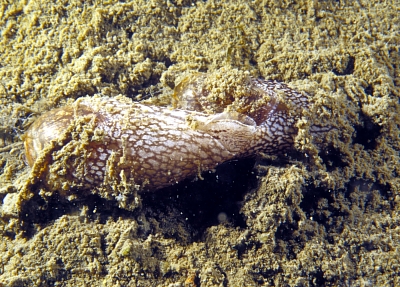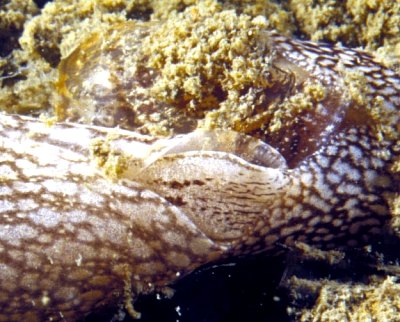Akera bullata from French Mediterranean [2]
June 20, 2007
From: Sylvie Grall

Concerning message #20044:
Dear Bill,
To accompany my contribution on Akera bullata and its ecology, here are photos of it mating. We meet this species every year in the Etang de Thau in the Mediterranean when they come out of the mud to breed. It takes place in March/April depending on the conditions. They appear as adults (we never saw small individuals) and seem to feed on the bottom. There is for a very short time (it seems to last only a few days) when we see them swimming up without obvious reason. After this they disappear again and we can find empty shells around.
Locality: Seawater lake, 8 m, France, Mediterranean, 14 april 2007, Muddy. Length: 8 cm. Photographer: Sylvie Grall.
Thank you.
Sylvie.
sylvgrall@aol.com
Grall, S., 2007 (Jun 20) Akera bullata from French Mediterranean [2]. [Message in] Sea Slug Forum. Australian Museum, Sydney. Available from http://www.seaslugforum.net/find/20050
Dear Sylvie,
I have split you message in two so we have a better look at this photo of two animals mating.
As I discussed before, Akera, although a primitive sea hare, has many features in common with the cephalaspidean bubble shells, with a large external shell and a hermaphrodite reproductive system in which the female opening is at the opening of the mantle cavity on the right side, within the shell opening, and the penis is at the front of the body on the right of the head. As I described in your last message [#20044], there is an external groove to carry the sperm from the female genital opening forward to the penis. When mating takes place these animals do not sit right side to right side like nudibranchs, but the animal acting as the male must have its head up on the right side of its partner so the penis can be in contact with the female genital opening. That is what we can see in the close-up photo alongside - the head of the animal in the foreground is acting as the male and has the front of its head squeezed in between the right parapodia and the shell of the animal behind which is acting as the female.
Best wishes,
Bill Rudman
Related messages
-
Looking for live Akera bullata
From: Jeffrey S. Prince, November 20, 2009 -
Re: Akera bullata swimming
From: Clare & Dick Donovan, April 21, 2008 -
Re: Akera bullata swimming
From: Barry Drinan, August 6, 2007 -
Re: Akera bullata swimming
From: Wellington Grey, July 5, 2007 -
Akera bullata from the French Mediterranean
From: Sylvie Grall, June 20, 2007 -
Akera bullata from Dorset, UK
From: Helen C Marshall, June 12, 2007 -
Re: Akera bullata swimming
From: Andrej Jaklin, July 20, 2006 -
Re: Akera bullata swimming
From: Ian Buzzard, July 18, 2006 -
Akera bullata swimming
From: Ian Buzzard, July 17, 2006
